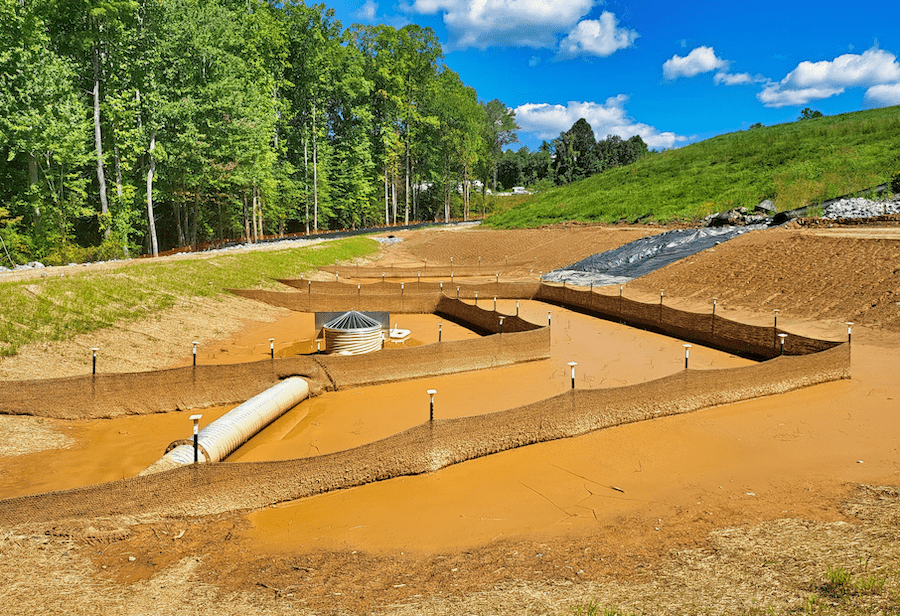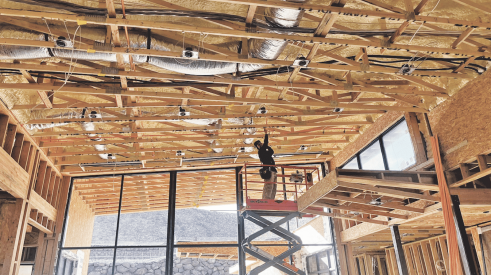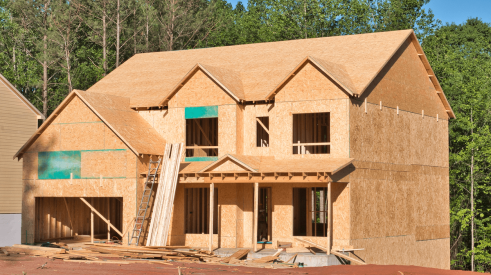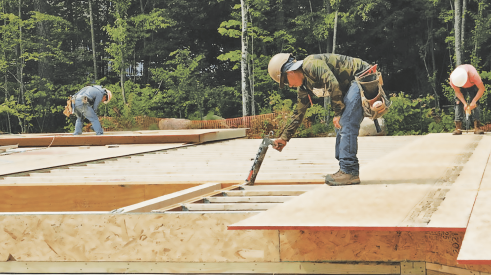When a home builder embarks on a new project, stormwater runoff is only one of a long list of things to worry about. That may be why it hasn’t been a high priority item for a lot of builders.
Over the last decade or so, however, stormwater has become a topic of serious conversation in the home building industry. The country got a firsthand look at the damage it can do when Hurricane Katrina blew through New Orleans in 2005, followed almost immediately by Hurricane Rita. While these were obviously extreme examples of the power of Mother Nature, everyday rain storms can cause problems for a builder if they’re not careful. This increased awareness has led to increased regulation surrounding stormwater management, starting with the U.S. Environmental Protection Agency (EPA).
While regulations add a mandatory component to the discussion, there are plenty of other reasons builders should make stormwater management a priority on their projects. Chuck Ellison, vice president of land at McLean, Va.-based single-family builder/real estate developer Miller & Smith, and chair of the NAHB Environmental Issues Committee, says stormwater can:
• Reduce the amount of available land on a property, negatively impacting value;
• Delay projects due to the extensive permitting process involved; and
• Lead to short- and long-term maintenance issues.
By the same token, Ellison adds, how you incorporate stormwater management into a home or community land plan can be a huge aesthetic boon, turning the property into a visual asset for the community.
Success Measured in BMPs
The EPA’s primary mechanism for enforcing stormwater management comes in the form of the National Pollutant Discharge Elimination System (NPDES) permit program. Under the terms of NPDES, builders must apply for a Phase II permit. Phase II emphasizes the use of in situ stormwater best management practices (BMPs) to reduce or eliminate runoff. BMPs are implemented across six categories, including construction and post-construction activities.
The permitting process itself is “very local,” according to Ellison. The EPA does handle stormwater permitting directly in many states, but delegates authority to state and local authorities in other cases. He relates the difference between doing projects in Delaware and Maryland, where six of Miller & Smith’s 11 communities are located: “In Delaware, the land is relatively flat, so the permitting process generally only takes a couple months,” he says. “But in Maryland, the land is rocky, and the process can take anywhere from six months to a year.”
Stormwater Solutions for Home Builders: Take Your Pick
So what options are out there for builders when it comes to handling stormwater? Solutions generally fall into three categories, according to Ellison:
• Impoundment systems capture and collect stormwater runoff in one central location, usually what amounts to a large hole above ground;
• Infiltration devices remove runoff from an area by absorbing it directly into the ground; and
• Structural devices capture or drain runoff as part of the home or other property.
As expected, each treatment type has its own set of advantages and disadvantages, and one size certainly does not fit all. “Solutions need to be site-specific,” says Ellison.
Impoundment Systems
Retention basins or ponds are the most common type of impoundment system, providing one central location for stormwater to collect. In some cases, smaller forebays may be installed upstream from the retention pond, where they can “catch the first flush,” according to Ellison, and prevent the retention basin from overflowing.
The major benefit of impoundment systems is they can often be utilized as green space on the property or in the community, playing host to different types of grasses and other plants; often, this can significantly enhance the aesthetic value of the property or community.
That aesthetic value is only as good, however, as the amount of regular maintenance put into the pond. Bob Rebori, president of Shawnee, Kan.-based Bio-Microbics, a manufacturer of engineered wastewater and stormwater treatment solutions, says, “Generally they have to try to keep it mowed and someone has to manually remove the trash,” adding that most often, the responsibility for maintaining the ponds ends up with homeowners associations.

The biggest downside of an impoundment system, according to multiple sources, is the negative impact it inevitably has on land value. Quite simply, if a retention pond is put in place, the builder automatically loses lots for potential development in the future. According to Ernie Platt of Clackamas, Ore.-based Ernest E. Platt & Associates, a real estate development consulting firm, “That’s usually about a 10-percent loss in productive lots, plus the cost of the structures, say around $100K for a 60-lot development.”
Infiltration Systems
Infiltration systems eliminate stormwater runoff by absorbing all of the water directly into the ground. On the surface, builders can install landscape beds, gravel, or any other porous medium. As the water drains, it is carried into and through an underground drainage system to the designated discharge point (usually a river or stream).
According to Rebori, there are three basic kinds of infiltration systems on the market today. The most basic are disposable filtration devices that must be cleaned and replaced after a rain event. “Witch’s hats”—nicknamed for their pointed-cone shape—are one such mechanism, where water passes through while trash and other pollutants are captured.
The second type of infiltration system is essentially a below-grade detention basin, often consisting of a plastic matrix that also captures trash. Rebori cautions that these need to be emptied regularly so the trash doesn’t plug the system.
The third and final option for infiltration systems is an engineered hydraulic system. The idea, according to Rebori, is to simultaneously filter stormwater runoff and capture and hold trash, with easy access for public works trucks to vacuum out the contents when full.
“During the early part of a storm event, that’s when the roads are most slippery because the rain is washing off the oils and the rubber,” he says. “That’s what you want to capture and hold.”
Structural Systems for Stormwater Management
For builders looking to incorporate stormwater management directly into their projects, structural systems are the way to go. Solutions in this category serve other primary functions on the jobsite, as well. A walkway made of pervious pavement is a perfect example, allowing enough spacing for water to drain while at the same time serving as a pathway to the home.
Green roofs are another popular structural-system option for stormwater management. Aside from beautifying a home, these rooftop gardens are traditionally built on top of a drainage system to remove excess stormwater. Depending on the situation—most likely during development of an entire residential community—parking lots can also be a resource for stormwater management.
Ultimately, says Rebori, builders should keep it simple and relatively inexpensive. “Even though something might be low-cost, if it’s expensive to maintain, after a couple storm events, one, you might have blown all your savings up front, and two, you might end up having to replace it anyway,” he adds.
Keep an Open Mind
Smart stormwater management is crucial to any project, no matter what type of system a builder chooses. Depending on the approach they decide to take, builders can also gain significant green building and energy-efficiency incentives. “There are several green certifications that really propel the use of smarter stormwater management,” Rebori says.
And, by being mindful of green building processes and techniques, builders can often improve the aesthetic value of their homes. “In a sense, wastewater and stormwater treatment in unsewered areas is becoming like an outdoor decorative item,” Rebori adds. “It gives you the street look the Realtors want you to have to sell your property.”
If builders are concerned about tackling the issue on their own, Ellison suggests “finding a good consultant who can think outside the box.” The NAHB Environmental Issues Committee is one potential resource, regularly working with builders to keep them up-to-date on the latest legislation as well as offering background information and tips for proper implementation. Other industry organizations like the American Society of Landscape Architects could walk a builder through permitting and implementation.
Whether they go it alone or need to seek help from others, builders should see the increased scrutiny of stormwater regulations as an opportunity to build better projects, says Rebori.
“In the end, it’s like some other new regulations—it doesn’t cost a lot of money, and there are a lot of extra benefits they get out of it.”
Advertisement
Related Stories
Construction
5 Steps to Cracking the Code for a High-Performance Home
As a model of energy savings, water conservation, indoor comfort and health, and use of on-site renewable energy, The New American Home 2024 offers valuable lessons
Single-Family Homes
What Does It Cost to Build a Single-Family Home?
A closer look at the itemized costs in each stage of construction for a single-family home
Quality Matters
5 Ways to Silence Squeaky Floors
Take these tips to heart to deliver quiet floors and satisfied homeowners







